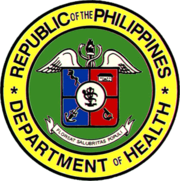- Department of Health (Philippines)
-
Department of Health Kagawaran ng Kalusugan 
Department overview Formed September 29, 1898 Headquarters San Lazaro Compound, Rizal Avenue, Manila Annual budget P31.829 billion (2011) Department executive Enrique Ona Website doh.gov.ph The Philippines’ Department of Health (DOH) (Filipino: Kagawaran ng Kalusugan) is the principal health agency in the Philippines. It is the executive department of the Philippine Government responsible for ensuring access to basic public health services to all Filipinos through the provision of quality health care and the regulation of providers of health goods and services.
Contents
History
On September 29, 1898, the Americans established a military Board of Health with Dr. Frank S. Bourns as president. The purpose of this Board of Health was to care for injured American troops but as the hostilities between Filipinos and Americans waned in 1901, a civilian Board of Health was now deemed appropriate with Dr. L. M. Maus as the first health commissioner.
In the early 1900s, 200,222 lives including 66,000 children were lost; three percent of the population was decimated in the worst epidemic in Philippine health history. In view of this, the Americans organized and erected several institutions, including the Bureau of Governmental Laboratories, which was built in 1901 for medical research and vaccine production.
The Americans, led by Dean Worcester built the UP College of Medicine and Surgery in 1905, with Johns Hopkins University serving as a blueprint, at the time, one of the best medical schools in the world. By 1909, nursing instruction was also begun at the Philippine Normal School. In terms of public health, the Americans improved on the sewer system and provided a safer water supply.
In 1915, the Bureau of Health was reorganized and renamed into the Philippine Health Service. During the succeeding years leadership and a number of health institutions were already being given to Filipinos, in accordance with the Organic Act of 1916. On January 1, 1919, Dr. Vicente De Jesus became the first Filipino to head the Health portfolio.
In 1933, after a reorganization, the Philippine Health Service reverted to being known as the Bureau of Health. It was during this time that it pursued its official journal, The Health Messenger and established Community Health and Social Centers, precursors to today's Barangay Health Centers.
By 1936, as Governor-General Frank Murphy was assuming the post of United States High Commissioner, he would remark that the Philippines led all oriental countries in terms of health status.[1]
When the Commonwealth of the Philippines was inaugurated, Dr. Jose Fabella was named chief of the Bureau of Health. In 1936, Dr. Fabella reviewed the Bureau of Health’s organization and made an inventory of its existing facilities, which consisted of 11 community and social health centers, 38 hospitals, 215 puericulture centers, 374 sanitary divisions, 1,535 dispensaries and 72 laboratories.
In the 1940s, the Bureau of Health was reorganized into the Department of Health and Public Welfare, still under Fabella. During this time, the major priorities of the agency were tuberculosis, malnutrition, malaria, leprosy, gastrointestinal disease, and the high infant mortality rate.
When the Japanese occupied the Philippines, they dissolved the National Government and replaced it with the Central Administrative Organization of the Japanese Army. Health was relegated to the Department of Education, Health and Public Welfare under Commissioner Claro M. Recto.
In 1947, President Manuel Roxas signed Executive Order (E.O.) No. 94 into law, calling for the creation of the Department of Health. Dr. Antonio C. Villarama as appointed Secretary. A new Bureau of Hospitals and a Bureau of Quarantine was created under DOH. Under E.O. 94, the Institute of Nutrition was created in 1948 to coordinate various nutrition activities of the different agencies.
On February 20, 1958, Executive Order 288 provided for the reorganization of the Department of Health. This entailed a partial decentralization of powers and created eight Regional Health Offices. Under this setup, the Secretary of Health passed on some of responsibilities to the regional offices and directors.
One of the priorities of the Marcos administration was health maintenance. From 1975 to the mid-eighties, four specialty hospitals were built in succession. The first three institutions were spearheaded by First Lady Imelda Marcos. The Philippine Heart Center was established on February 14, 1975 with Dr. Avelino Aventura as director. Second, the Philippine Children’s Medical Center was built in 1979. Then in 1983, the National Kidney and Transplant Institute was set up. This was soon followed by the Lung Center of the Philippines, which was constructed under the guidance of Health Minister Dr. Enrique Garcia.
With a shift to a parliamentary form of government, the Department of Health was transformed into the Ministry of Health on June 2, 1978 with Dr. Clemente S. Gatmaitan as the first health minister. On April 13, 1987, the Department of Health was created from the previous Ministry of Health with Dr. Alfredo R. A. Bengzon as secretary of health.
List of Secretaries of Health
Name Term Began Term Ended President Fifth Republic of the Philippines Alfredo Bengzon 1987 1991 Corazon Aquino Antonio Periquet 1991 June 30, 1992 Corazon Aquino Juan Flavier June 30, 1992 1995 Fidel Ramos Jaime Galvez-Tan 1995 1995 Fidel Ramos Hilarion Ramiro, Jr. 1995 1996 Fidel Ramos Carmencita Reodica 1996 1998 Fidel Ramos Felipe Estrella 1998 1998 Joseph Estrada Alberto Romualdez 1998 January 20, 2001 Joseph Estrada Manuel Dayrit January 20, 2001 June 1, 2005 Gloria Macapagal-Arroyo Francisco Duque III June 1, 2005 January 2010 Gloria Macapagal-Arroyo Esperanza Cabral January 2010 June 30, 2010 Gloria Macapagal-Arroyo Enrique Ona June 30, 2010 Present Benigno Aquino III References
External links
Categories:- Healthcare in the Philippines
- Health ministries
- Ministries established in 1898
- Government departments of the Philippines
Wikimedia Foundation. 2010.
